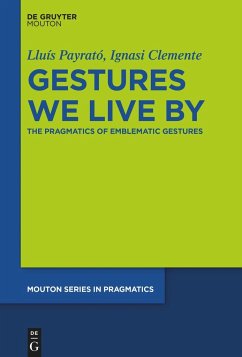This book examines emblems (or emblematic gestures) from a pragmatic view, that is to say, as autonomous gestures that fulfill communicative functions, embody illocutionary values, and act as signals of cognitive relevance.
Emblems are conceived as multimodal tools on the frontier between verbal and nonverbal modes, and are part of the communicative repertoire of individuals and sociocultural groups. Emblems constitute clear cases of embodiment and are susceptible to many processes of metaphorization (contrasting or not with verbal metaphors), metonymy, and interference between modalities. The applications of emblematic analysis are numerous, from lexicography to second language learning, or to natural language processing.
Emblems are conceived as multimodal tools on the frontier between verbal and nonverbal modes, and are part of the communicative repertoire of individuals and sociocultural groups. Emblems constitute clear cases of embodiment and are susceptible to many processes of metaphorization (contrasting or not with verbal metaphors), metonymy, and interference between modalities. The applications of emblematic analysis are numerous, from lexicography to second language learning, or to natural language processing.
"Für die praktische Theologie und Gottesdienstlehre bietet dieser für fachfremde Theolog/inn/en anspruchsvolle Band interessante Anregungen in Zeiten zunehmender Visualisierung bzw. visueller Wahrnehmung auch des Glaubens, der Kirche und ihrer Strukturen. Er sensibilisiert für die Frage, ob und wie christl. Inhalte körperlich bzw. körperlicher vermittelt werden können." Prof. Dr. Christoph Stenschke in: Theologische Revue 117/2021








